|
|
 |
|
|
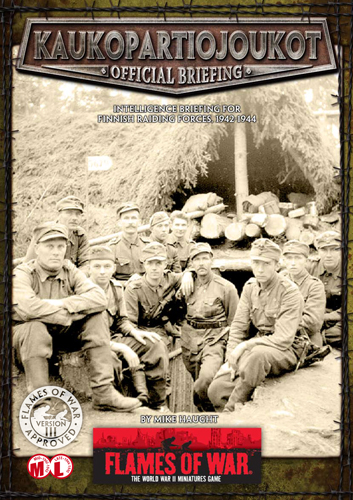 |
Kaukopartiojoukot:
Finnish Raiding Forces, 1942-1944.
by Mike Haught
When the Soviets invaded Finland during the Winter War of 1939, the intelligence department of the Finnish military recognised the need for specialized long-range reconnaissance patrols to raid and gather intelligence deep behind Soviet lines.
The first units were formed and trained in
secrecy, including three
guerrilla detachments, called Hiihtosissit, or skiing guerrillas. However, the troops did not see much action before the
Winter War ended
in 1941.
|
Kaukopartiojoukot
1941 - 1943
During the uneasy peace following the Winter War, the Finns secretly
continued to train and expanded their guerrilla force. A new type of
patrol, called a Kaukopartiojoukot, or long-range scout patrol, was
formed to conduct long-range reconnaissance and guerrilla strikes far
behind the enemy lines.
The troops consisted of physically and mentally fit volunteers, mostly
young athletes such as skiers and runners. The missions that the patrol
would undertake required calm nerves under extreme pressure and
conditions.
|
Company-sized patrols would enter into the Soviet Union through the
loose Karellian front lines on foot or by skiing. Once behind enemy
lines they would establish a base of operations, leaving a small unit to
guard the HQ and the patrol’s radio. Meanwhile, the company would break
up into platoons or squads to conduct their mission. These small
patrols were typically only about a platoon of troops (30-50 soldiers).
Only a few company- and battalion-sized patrols
were deployed. These were formed to conduct certain high profile
operations, such as striking well-guarded supply centres, cutting the
Murmansk railway or disabling the Stalin Canal. The patrol was
occasionally reinforced for these missions with guerrilla, Jääkäri
(light infantry), and engineer troops from the regular army.
|
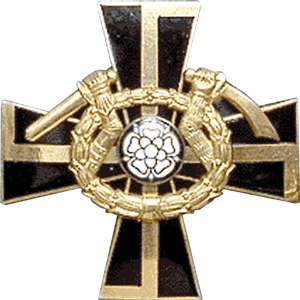
|
A Kaukopartiojoukot usually conducted reconnaissance missions, however
they were also authorised to launch raids on the enemy. Typical raids
targeted small convoys, Soviet officers, supply trains, and airfields.
They also placed mines on important roads and railways and tapped into
the Soviet communication lines to gather intelligence and radio back to
Finland for analysis.
Learn about the Train Attack scenario here...
The Soviet guard units pursued the patrols as
best they could, but more often than not the sly Kaukopartiojoukot
managed to slip away to safety thanks to superior training, a remarkable
radio network, and detailed knowledge of their opponents. In fact, the
patrol often knew more about their Soviet pursuers than the Soviets knew
of themselves!
|
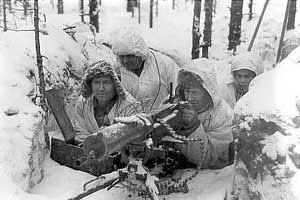 |
Other Long-Range Patrol Units
Other units, such as the Sissi (guerrilla) and Jääkäri (light infantry)
conducted similar operations as the Kaukopartiojoukot, but otherwise had
little in common with the long-range patrols. These units undertook
more traditional scouting and patrolling missions and operated much
closer to the front lines under the command of the local army corps,
division or regiment.
|
The Kaukopartiojoukot Battalion
In July 1943 all of the various Kaukopartiojoukot
patrols were grouped
together into Erillinen Pataljoona 4 (Separate Battalion 4). The full
strength of the battalion was 678 men and 76 women. There was even an
Estonian volunteer patrol within Separate Battalion 4.
In 1943, the battalion sent over 50 patrols
behind the lines and over
100 were sent the following year. The
intelligence gathered was very important and
critical to the Finnish
military, especially in the summer 1944 during the Soviet offensive.
After the Continuation War, Separate Battalion 4 deployed against the
Germans during the Lapland War before it was disbanded in November 1944.
|
A Kaukopartiojoukot
Company
On paper the typical Kaukopartiojoukot Company at full strength
consisted of 156 men and 15 women, but in reality companies never had
enough personnel. The company was organized with three Kiväärijoukkue
(rifle) platoons each with four Kivääriryhmä (rifle squads) for a total
of 35 troops.
Each company also had a Radioasema (radio station) platoon with 11
soldiers detached from the Radioasema company. These were in constant
contact with the battalion headquarters.
Finally, each company had a Huoltojoukkue
(supply) platoon which handled the company’s logistic needs. The 33
troops of the platoon were also expected to fight should they be needed.
|
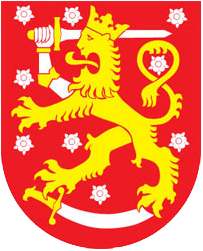
|
Special Equipment
The Kaukopartiojoukot had access to some truly innovative technology to
help them conduct their operations. For
example, they used a chemical liquid that confused dogs’ sense of smell
so they could evade Soviet patrols. Special
snow track mines were used to deploy small minefields as well as
improvised explosives. They also acquired a number
of German smokeless petrol cookers in late 1943 which helped keep their
camp concealed from the Soviets.
Perhaps the most valuable piece of equipment in the patrol was the small lightweight guerrilla telegraph radio
called a Kyynel, (literally translated as ‘tear’ owing to its shape) and a simple radio receiver called a Töpö, or stump. These innovative radios kept the patrols in constant contact with HQ and gave Finnish intelligence critical information in near real-time.
|
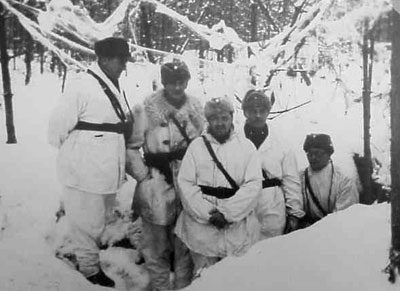 |
Radios and Message Encrypting
The first Kyynel radios were inspired by a German radio design which weighed 33 pounds (15kg).
The Finnish developed the Model M10 in 1942 which was fully stabilized and weighed only 12 pounds (5.6 kg) with batteries. Other contemporary foreign designs weighed a lot more, usually between 22 to 44 pounds
(10 to 20kg). This ingenious Finnish guerrilla radio was the most advanced one of its kind in the world.
|
The radio would transmit at a frequency of 3500 - 5000 kHz and had
sending power of up to 0.5 Watts, depending on
the power of batteries. This gave the radio a range of up to 435 miles
(700km) in good weather.
Patrols sent encrypted messages using a simple but effective code
pattern created exclusively for each patrol, which made it impossible to
solve without a key.
Finnish Radio Intelligence had also decrypted many Soviet codes, which
gave Kaukopartiojoukot patrols plenty
of warning should there be any possible danger in the area. |
Uniforms and Armament
The patrols wore standard Finnish military uniforms. Sometimes they would use a combination of Finnish and captured Soviet uniforms so as to confuse enemy patrols if spotted far away.
While officially called rifle platoons, each patrol was primarily armed with the highly accurate and reliable 9mm M/31 Suomi Submachine-gun. However, at least one man in the patrol carried a rifle for long-range shooting.
|
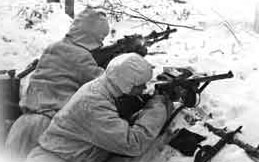 |
A Kaukopartiojoukot In Flames Of War
A Kaukopartiojoukot is fielded in Flames Of War as a 500-1000 point raiding force, similar to the SAS and LRDG forces found in Sting of the Scorpion. However, it can also be fielded at 1500 or more points for those players willing and daring enough to take on larger raids!
|
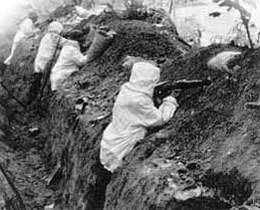 |
The following intelligence briefing will allow
players to conduct all of the raid missions found in that publication as
well as the ones found on the website. These raiding missions are great
for recreating the tasks undertaken by the Kaukopartiojoukot. However,
be sure to check out Wargames Illustrated issue 270 (also coming soon to
the website) for a new raiding mission for your Finnish troops along
with a battle report featuring a Kaukopartiojoukot in action!
A Kaukopartiojoukot uses standard Finnish models. They fought all year round and thus any of your existing Finnish models will work perfectly.
You can also use Soviet figures as well for those troops you equip with
Soviet Uniforms.
|
Typically, a Kaukopartiojoukot would face Soviet security troops which differed little from the standard Strelkovy battalions used by the Soviet Union. They also saw action against the Germans during the Lapland War, making them valid opponents as well. Of course, you can play against any army you like!
This briefing can be used in both Mid and Late-war games, as the equipment and rating of the troops did not change
between the eras.
|
Fielding a Kaukopartiojoukot in Flames Of War
Fielding a Kaukopartiojoukot is a perfect way
to emulate the daring raids and missions undertaken by these elite
troops. The raids were small, usually consisting of a single platoon
with some support. There were also larger missions you can recreate such as cutting the Murmansk railway. |
Last Updated On Tuesday, August 21, 2012 by Wayne at Battlefront
|
|
|